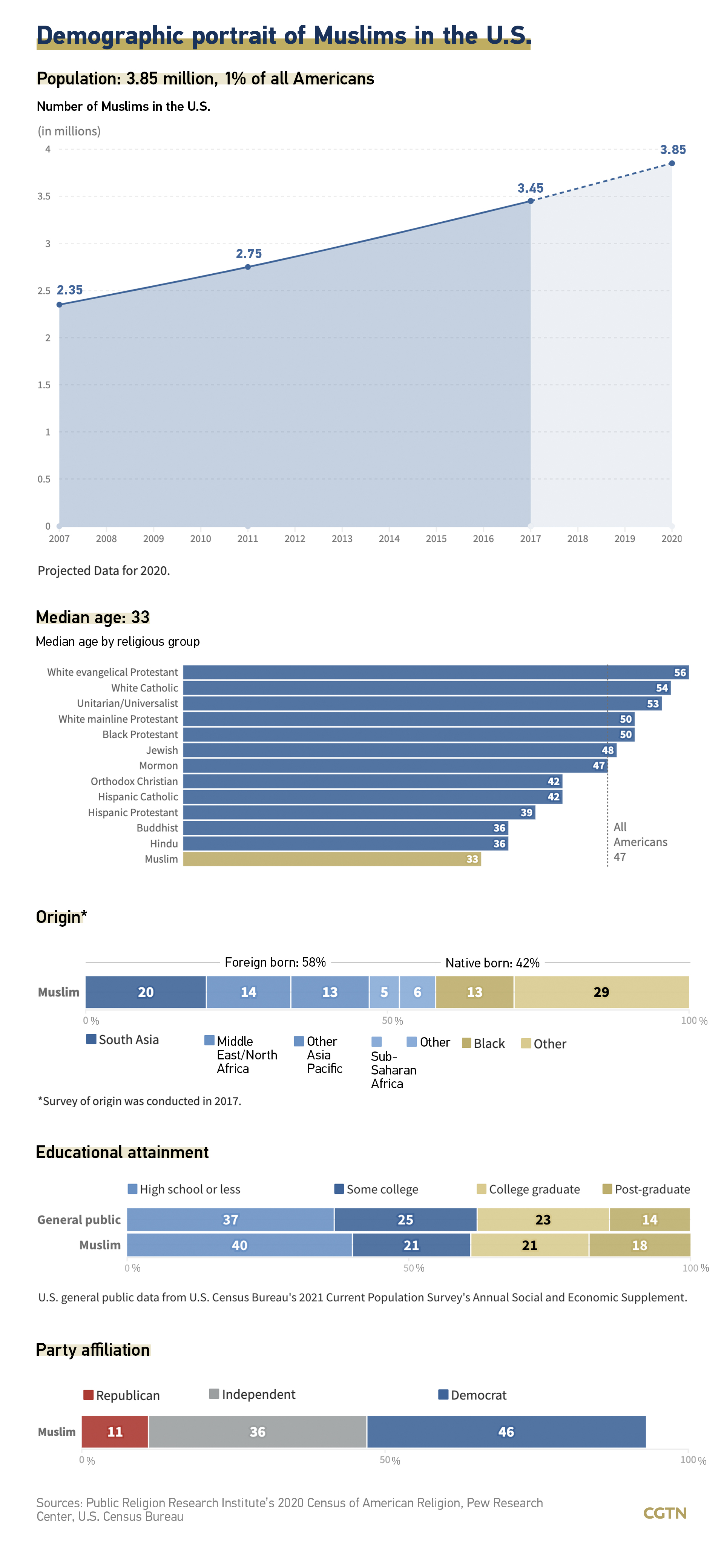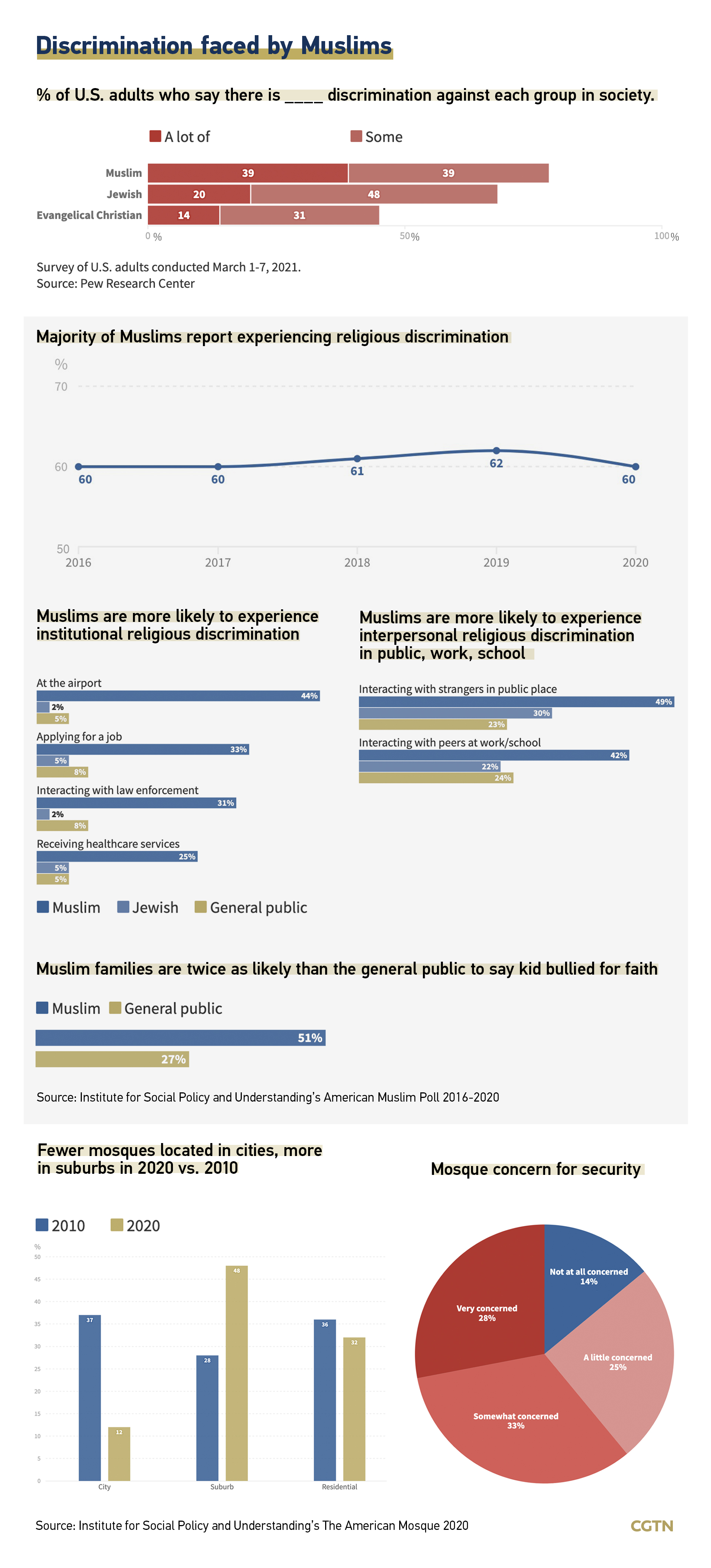Muslims represent a relatively small but rapidly growing portion of the U.S. religious landscape. But even as the community expands, the Islamophobic backlash in post-9/11 America continues.
Pew Research Center projected that about 3.85 million Muslims were living in the U.S. by 2020 – roughly 1 percent of the total U.S. population, up from about 3.45 million in 2017. Growth has been driven largely by the continued flow of Muslim immigrants into the country.
Approximately 60 percent of U.S. Muslims aged 18 and over were born outside the U.S., with origins spread throughout the world. The most common region of origin for Muslim immigrants is South Asia.

Half of Americans, including a large majority of Republicans, say Islam encourages violence. That is twice the number who held that view in early 2002.
Americans were more likely to say they believe Muslims face "a lot" of discrimination than to say the same about other religious groups, as indicated by a March 2021 Pew Research Center survey.
According to the Institute for Social Policy and Understanding (ISPU)'s American Muslim Poll 2020, more than any other group that experiences religious discrimination, Muslims do so on an institutional, not just interpersonal, level.

While the number of Muslim houses of worship in the U.S. has more than doubled over the last two decades, major declines occurred in the number of mosques located in small and large cities. Mosques in cities decreased from 37 percent of the total in 2010 to 12 percent in 2020, possibly tied to the dwindling population of Muslims in these cities due to the drying up of jobs and the general move to suburban locations.
Most mosques evinced security concerns, according to the ISPU's U.S. Mosque Survey 2020. Paying for professional security increased dramatically, from 10 percent of mosques before 2015 to 28 percent after 2015.
Islamophobia and hate crimes against Muslims are not new in America but statistics from the FBI's Uniform Crime Reporting program show anti-Muslim hate crime incidents spiked after September 11, 2001, jumping from 28 incidents in 2000 to 481 in 2001.
The numbers generally dropped in the following years, even as the Muslim population grew, though did increase a bit in 2015 and 2016. However, they have never returned to the levels reported before the 9/11 attacks.

An unprecedented amount of public attention was focused on Muslim Americans in the wake of the 9/11 terrorist attacks, and yet prior to 9/11, Muslims had faced a rise of anti–Muslim hostility in the U.S., including negative representations of Muslims in the news and popular culture, the post-Cold War construction of the "Islamic threat" by U.S. political leaders, the selective targeting of Muslim immigrants by law enforcement officials, and the growing number of religious–discrimination lawsuits filed in state and federal courts, says Lori Peek in the book "Behind the Backlash: Muslim Americans After 9/11."
In the aftermath of 9/11, Muslims became the public and political scapegoats, Peek says. "Key elected officials, desperate to demonstrate progress in the post-9/11 'War on Terror', encouraged Americans to accept harsh and discriminatory tactics ostensibly designed to keep the nation safe from so-called threatening outsiders."
"For years, the 'war on terror' has continued to write the script of what's allowable for Muslims to think, say and do," wrote Moustafa Bayoumi, the author of the award-winning books "How Does It Feel To Be a Problem?: Being Young and Arab in America" and "This Muslim American Life: Dispatches from the War on Terror."
Read more:
September 11 attacks: Facts and impact

